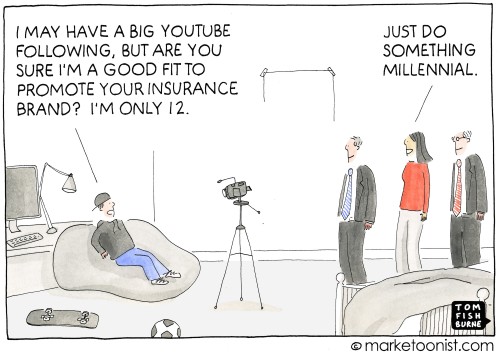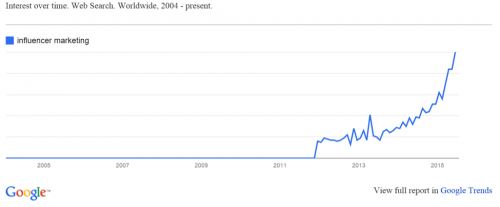Why brands should use influencers
B&T recently published this article by me about the benefits of working with social media influencers. They’ve been kind enough to let us reproduce it in full below.

We all love to claim that we ‘never watch television’… but my 12-year-old daughter genuinely doesn’t.
She literally hasn’t set finger on the TV remote in over a year.
From a professional perspective, it set me wondering: if there’s a generation coming through who will never watch linear television – and I now firmly believe they never will – how can we help brands reach them?
Let’s start by looking at what my daughter’s media consumption actually is, if it isn’t TV. She’s listening to music on Spotify, watching movies or series on Netflix, she’s talking to her friends on Instagram, but more interestingly, she’s watching heaps of YouTube content. And once I got under the skin of what she was watching, it really rocked my world.
She’s not much of a girly-girl, but she’s watched countless hours of fashion and make-up tutorials from Zoella and Bethany Mota. She’s no gamer, but knows exactly who PewDiePie is. She gets her giggles from Natalie Tran and Nigahiga, and she follows Troye Sivan, Tyde Levi and Tyler Oakley like a religion. Between all of whom they have a combined audience greater than the population of Australia. In fact, PewDiePie alone has almost twice as many subscribers as we do citizens.
And she’s not just watching their content on YouTube; she’s following them on other social channels like Instagram and Twitter.
It’s possible you’ve never heard of any of these characters, but let me tell you, they are more influential amongst this younger age cohort than any TV celebrity. With literally millions of followers apiece, they have greater reach than many Hollywood movie stars.
Clearly, plenty of movie stars also have big social followings, but if you want them to do a celebrity endorsement, it comes with a multi-million dollar price tag, whereas with the new-school ‘influencers’, you are talking just tens of thousands, if that.
And it’s not just tweens who are tuning-in to influencers; there’s mummy bloggers who are setting political agendas, fashion Instagrammers who are creating seasonal trends, and YouTubers who are making or breaking tech product launches.
Brands are beginning to understand the power of these wunderkinds, but something tells me we’re only at the start of this new wave of marketing. Certainly, most conversations we’re having with clients at We Are Social involve an aspect of influencer marketing.
This recent article in Adweek makes a very compelling argument for why any marketer should be considering Influencer Marketing as part of their programme. One of the ten reasons they gave was that it’s an arbitrage – something that is selling for cheaper than it’s actually worth. Which makes it an even more interesting phenomenon when you consider that mainstream media is probably selling for more than it’s worth.
The other thing I find incredibly interesting about this trend is that most of the content would never be commissioned by mainstream television networks, yet seems to be reaching far bigger audiences than any of our ‘top rating’ shows.
This recent Variety article ranked the top 12 digital ‘famechangers’, and you’ll notice that most of them focus on what could be considered quirky or ‘niche’ topics, but regardless, they are finding huge audiences. In the democratised world of YouTube, where content isn’t commissioned by the powers-that-be at the top of a network, but subscribed-to by the viewer, we are perhaps seeing a truer reflection of people’s real passions and interests, whether that be gaming, science, or even acrobatics.
The production values are rubbish, but the audience just don’t care. If anything, it seems to add to the relatability of the stars.
Awareness of the phenomenon is definitely on the rise – the table below from the above mentioned Adweek article shows the steep rise in the number of searches for the term ‘influencer marketing’ – but I’m still surprised by the number of people I speak to who aren’t yet fully aware of the impact and reach of these influencers, or clients who don’t see the value in it.
At We Are Social we have been working with influencers for some years now, so have built up strong relationships with many of them.
For example, we worked with Mighty Car Mods – the only Australian entry into Variety’s list of top 12 Digital Famechangers – to support the launch of Roadshow Films’ Mad Max: Fury Road.
We’ve found that the process of creating a successful influencer campaign involves working closely with the influencers to design content that will seamlessly integrate the brand message in a way that appeals to their audience. The influencers are very aware of what their audience like and don’t like, since they have personally grown and tended to their audience over time, and will not do anything that they think will alienate their audience.
Additionally, we always aim to work with influencers who have a true interest in or affinity to the brand. In the case of Netflix, we worked with a whole host of influencers to support the launch in Australia, including developing what turned into a blockbuster campaign with Troye Sivan to promote Netflix’s Originals Series, Unbreakable Kimmy Schmidt. In planning the campaign, our social listening research highlighted that many of these key influencers were already organically talking about and eagerly anticipating Netflix’s arrival in Oz, so working with them as ambassadors made total sense. They were able to credibly endorse the brand, and it worked its socks off.
So next time your agency recommends influencers as part of your marketing campaign, I strongly recommend you give it serious consideration. They potentially have greater reach than mainstream media at a more efficient price, and more genuine influence than most celebrities.
